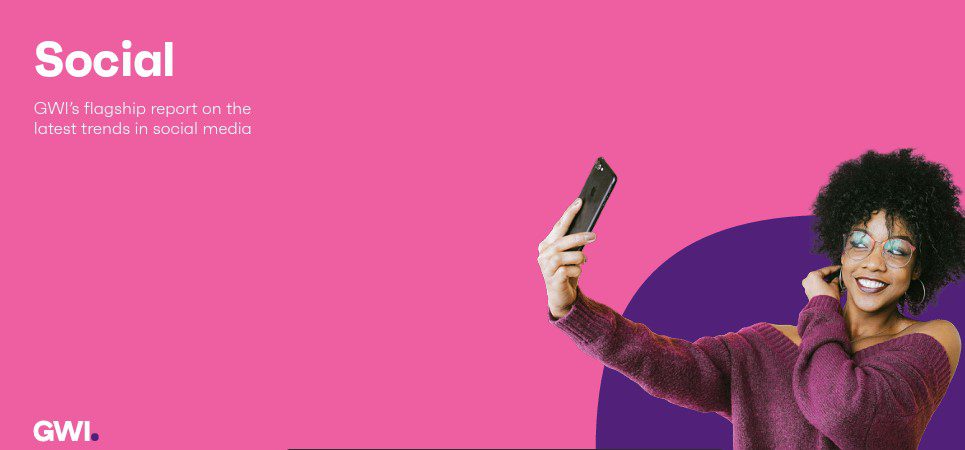1997. Social media is born.
Fast forward to 2022 – the world of TikTok, augmented reality and influencers. The latest report from GWI looks at what’s changed and the most recent trends.
- Social media usage has plateaued. Since Q2 2021, time spent on social media has increased in 32 of the 47 countries we track, with consumers in MEA upping their usage by around 20 minutes in the space of a few months. This sounds promising, but after taking a step back, we can see that global engagement has generally slowed down. Time spent on social media has been a bit of a rollercoaster over the last 5 years. Between 20142018, the average time spent on networks was making steady strides forward, increasing by almost 40 minutes. The numbers then started to plateau in 2019, only to be interrupted by the pandemic. Q2 2020, when around half the world’s population was under some form of lockdown, still boasts the highest figures on record for global usage. Back then, the long-term impact of this uptick wasn’t clear; but it is now. Engagement has fluctuated a little, but ultimately leveled off. If we take MEA out of the equation, the global average is what it was three years ago.
- Gen Z social media is coming of age. Despite growing competition, Facebook isn’t going anywhere. It tops our global leadership board and most younger consumers use it each month. Especially with so many websites using Facebook Login to speed up the sign-in process, it’s well-embedded in people’s online experience. That being said, Gen Z has a special place for Instagram. In every quarter since Q2 2019, more 16-24s have visited Instagram than Facebook. A quick glance back at their social media motivations helps explain this: for all other generations, finding news is one of their top three reasons for using social networks; whereas Gen Z places more priority on finding content and seeing what’s trending.
- The main differences between markets. The Chinese market is a potential goldmine for international businesses looking to expand. But the nation’s social media landscape, with its own set of homegrown platforms, can seem intimidating at first. So, GWI has highlighted some key insights to help companies make sense of this space. For example, Social media typically fulfils a wider brief in fast-growth markets like China than in the West. Consumers in Asia Pacific over-index most for using platforms to watch livestreams, and those in Latin America for finding things to buy; whereas in North America, the most distinctive reason for logging on is keeping in touch with friends and family.
- Keeping tabs on behavioral trends – why short-form videos are on trend. Across every age group and country in our Zeitgeist study, short-form content is more popular than long-form. TikTok may have kickstarted a new era of bite-sized videos, but many social platforms now offer their own alternative. Reels have been around for some time, but they’re picking up steam. In fact, there’s been a 20% increase in the number of Instagram users engaging with this feature since 2020. Companies need to meet consumers where they are to make the most impact, which means upping their investments in this format is likely to pay off. Short videos are quick to create and tend toward the less polished, more spontaneous content people are after.
- Marketing in the metaverse. First coined in a 1992 novel, the term “metaverse” is thought by some – Mark Zuckerberg included – to represent the future of social media, if not the whole internet. But for all the buzz around it, what do consumers actually think? Most internet users (70%) have heard of the term, though the majority of those (53%) don’t actually know what it means. 51% would be interested in participating, though this drops with age. It’s too early to say if the metaverse is the next big thing, but there are useful insights we can share with brands looking for a first-mover advantage.
- How research leads to discovery. Overall, search engines (32%), ads seen on TV (31%), and word-of-mouth recommendations (28%) top our brand discovery chart. But social media comes in all shapes and sizes, with sources like Q&A sites also falling under its umbrella. ROI agency Zenith predicts that 2022 is the year that’ll see social media’s ad market overtake TV, which seems reasonable given how big this channel’s combined impact is. Even if we look at the habit of researching products on social networks alone, we can see they’re slowly gaining on search engines. The space between the two, which was 7 percentage points in 2020, now rests at 4. Plus, Gen Z passed an important milestone in Q3 2020; social networks are now the most common way they find out about brands or products. For them, the gap has already been filled and then some. Traditional formats are still important and this is unlikely to change anytime soon, but social networks are taking up more room at the discovery table.
Explore the biggest trends and behaviors around the world with GWI’s full latest social flagship report.

